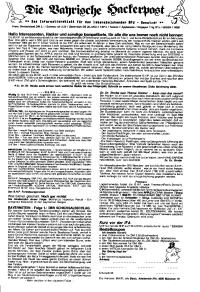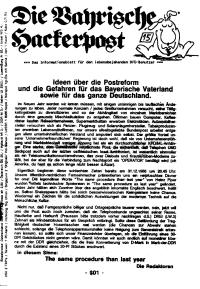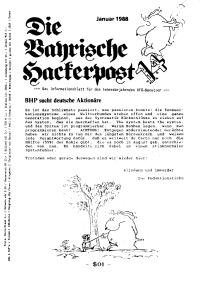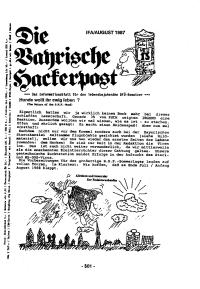Copy Link
Add to Bookmark
Report
Cider Digest #0635

Subject: Cider Digest #635, 25 December 1996
From: cider-request@talisman.com
Cider Digest #635 25 December 1996
Forum for Discussion of Cider Issues
Dick Dunn, Digest Janitor
Contents:
Sweet Cider Questions (re Digest #633) (Andrew LEA)
Re:Stevia (PickledMan)
HELP!!! Cloudy cider (Mirra@aol.com)
Last year's cider vs. this year's (Steve Armbrust)
Send ONLY articles for the digest to cider@talisman.com.
Use cider-request@talisman.com for subscribe/unsubscribe/admin requests.
When subscribing, please include your name and a good address in the
message body unless you're sure your mailer generates them.
Archives of the Digest are available for anonymous FTP at ftp.stanford.edu
in pub/clubs/homebrew/cider.
----------------------------------------------------------------------
Subject: Sweet Cider Questions (re Digest #633)
From: Andrew LEA <101750.3071@compuserve.com>
Date: Sat, 21 Dec 1996 14:29:47 -0500
In reply to Brian Dixon's "Open letter" re keeving:
1. I don't know whether you can buy calcium chloride easily in the US.
Fortunately I'm in the scientific research business so it's not a problem
for me. In the UK I would just try to order it from a High Street chemists
shop and wouldn't expect any difficulty. When I was a kid I could get any
harmless chemical over the counter that way ( and some pretty harmful ones,
too, so long as I had a note from my parents!).
2. The chalk / salt mixture comes straight out of a French booklet
"Comment faire du bon cidre" published about 20 years ago from the Cider
Research Institute in Rennes, and goes back to Warcollier or beyond. It
simply says to add 30 grams of powdered chalk and 40 grams of fine table
salt per hectolitre of juice (or to buy 'les sels defecants' which are
available commercially in France). This is 300 or 400 parts per million,
milligrams per litre, or however you want to express it. It's just maths!!
The 500 ppm calcium chloride IS damn near equivalent because of the
differing molecular weights of the relevant ions (calcium, sodium and
chloride). Anyway, you don't have to be too exact about this. 400 ppm of
salt only gives you 400* 23/(23+36) = 156 ppm of extra sodium.
3. When the salt hits the juice, the sodium and chloride dissociate for
ever - it's the chloride ion that then inhibits the yeast. The sodium
don't do nuffink - just floats around! When the chalk hits the acid juice,
the carbonate disappears as carbon dioxide, leaving the calcium ion
balanced by the malate of the juice and eventually, we hope, complexing
with the pectate. By this means you get in there the two active
ingredients (calcium and chloride) that you need.
4. I'm not a brewer so I'm not sure about adding calcium chloride to beer
- - here I think it's calcium sulphate which is added (Burtonising?). No
doubt someone will correct me. But this is for entirely different reasons
to adding it in cider.
5. Addition of sulphite - 1 Campden tablet is formulated to provide 50 ppm
of SO2 when added to one imperial gallon. Or you can make a 10% solution
of sodium metabisulphite, which gives roughly 5% SO2. Add 1 ml of this
per litre and you get 50 ppm. After that, again, it's just maths. One '%'
is one part per hundred and one 'ppm' is one part per million.
6. Yes there is an empirical relationship between the amount of SO2 to add
for complete microbial inhibition and the pH of juice but it's too
complicated to go into here - the rules of thumb are given on my web page
anyway. But because the wild bacteria are somewhat more sensitive than the
wild yeasts (Kloeckera apiculata is quite SO2 tolerant, apparently), you
can add somewhat less than this 'official' amount and get some selective
inhibition. That's what I was recommending - the 'official' amount of SO2
at pH 3.8 - 4 is about 200 ppm (incidentally at the top of the legal
range), so if you only add 100 ppm you'll not get the full effect.
7. Let's be honest and say that keeving is still something of an art!
Mine hasn't worked so well this year as I'd hoped and the 'chapeau brun' is
a bit thin and hasn't cleared all the turbid juice below as it should!
This is possibly because the apples were too hard and therefore not enough
pectin and esterase leached out before I pressed - another months storage
would have softened them. Traditional keeving was often delayed till well
into December. More skill needed!!
Andrew Lea, Oxford, UK
andrew_lea @compuserve.com
------------------------------
Subject: Re:Stevia
From: PickledMan <wrp2@axe.humboldt.edu>
Date: Sat, 21 Dec 1996 12:51:06 -0800 (PST)
Glenn & Christina,
No luck w/ the stevia yet? Found it wasn't useful for cider and
am reserving it for use in tea. I have had good luck w/ sorbates, but
that requires art. CO2 if you want bubbles. I am going to do a sweet
stout using some stevia instead of dextrin malt.
PickleMan
.."(PickleMan) always makes a fashion statement. Unfortunately, it says,
'Don't try this at home.'" -Chikngrrl
------------------------------
Subject: HELP!!! Cloudy cider
From: Mirra@aol.com
Date: Sun, 22 Dec 1996 07:57:13 -0500
This year I didn't measure the specific gravity
of my sweet cider/juice (kick me!) then I add
1/2 lb. dark brown sugar ( Dixie Crystral brand)/
gallon, 1/2 tspn /gal yeast nutrient ( amonium
phosphate), 1 gram/gal Red Star Pastuer Cham-
pagne yeast. Fermented to dryness at 72-76 F.
Didn't measure the specific gravity (kick me again)
so I don't know the actual alcohol content ( but it"
seems " to be over 12%). Added pectin enzyme
(10 drops/gal); no clearing. Moved to a cooler (50 F)
location); no clearing. Added more pectin enzyme
(5 drops/gal); no clearing. The cider tastes good;
dry, appley but is cloudy (like muddy water). If the
alcohol content is so high that the pectin enzyme
is being inhibited (killed) is there another way to
clear this brew ? Help!!!
------------------------------
Subject: Last year's cider vs. this year's
From: Steve Armbrust <stevea@thepalace.com>
Date: Mon, 23 Dec 1996 08:03:35 -0800
Hi fellow cider lovers,
Last weekend I sampled the first bottle of this year's cider production =
and compared it with the lone remaining bottle of last year's batch =
which I had been hiding in the back of the refrigerator for at least =
nine months.
Contrary to what I had believed, the year-old cider had not gone bad, =
even though it had been fermented with natural yeast. It was clear, =
with a nice apple aroma and a hint of sweetness. And the sulfury nose =
that characterized it earlier was gone. I wish I had a case of it.
The new batch used basically the same recipe but with a significant =
difference. I used cider from the same orchard in Hillsboro, Oregon and =
augmented it with two cups of honey. But instead of letting the natural =
yeast have its way, I treated the juice with campden tablets and dosed =
the batch with a wine yeast (montrachet??). The resulting cider is =
still a bit young and not fully carbonated in the bottle (I just =
couldn't wait any longer to try it). So it has a little off flavor that =
I think will smooth out with time. But it is very, very dry. I had =
even treated it with apple extract at bottling time to beef up the aroma =
and flavor. But until I compared it with last year's batch, I didn't =
realize how much complexity and flavor was missing.
It will still turn out to be a good cider, I feel. But I'll have to =
think of it more like a sparkling wine and drink it out of champagne =
glasses instead gulping it from a sturdy mug. Which is really what I =
want to do. So next year, I think I'll go back to using natural yeast, =
or maybe this Normandy method with CaCl, if all you smart folks can help =
me figure it out by then.
Happy holidays, and thanks for all the great information!
Steve Armbrust
stevea@thepalace.com
------------------------------
End of Cider Digest #635
*************************


























